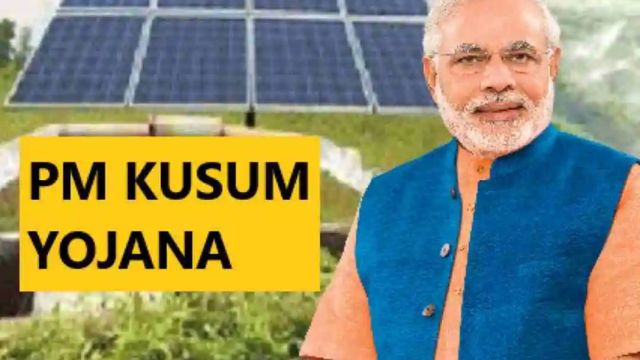The Central Government has announced the Kisan Urja Suraksha evam Utthaan Mahabhiyan (KUSUM) scheme, which aims to increase solar electricity output in India while also providing farmers with the benefits of solar farming. The Union Budget 2018-19 allotted Rs.48000 crores for this scheme over a ten-year period.
In March 2021, the Central Government modified an existing component of the PM-KUSUM scheme – a farmer income assistance and a de-dieseling scheme – to focus on solarizing agricultural feeders rather than pumps. Farmers would no longer be required to replace every current pump in a hamlet with a solar pump if this action were taken.
Overview Of Kusum Scheme 2023
- The New and Renewable Energy Ministry is in charge of implementing the Kusum Scheme.
- Initially, 1.75 million off-grid agricultural solar pumps will be distributed by the government.
- 10000 MW Solar farms will be built on unused land.
- The increased solar power generated by farmers on barren lands will be purchased by the state electricity distribution firms, or DISCOMS. DISCOMS will receive subsidies to purchase this electricity.
- Government tube wells and current pumps will be retrofitted to work on solar power.
- Solar pumps will be subsidized by 60% for farmers. It will be transferred immediately to their bank accounts. The national and state governments will share this subsidy. A bank loan will cover 30% of the costs. As a result, the farmers will bear only 10% of the remaining costs.
Components of the PM-KUSUM Scheme
Component-A: Addition of 10,000 MW of solar capacity through the installation of small solar power plants with capacities ranging from 2 MW to 5 MW.
Component B: Installation of 20 lakh solar-powered farm pumps on their own.
Component C: Solarization of 15 lakh current grid-connected agricultural pumps
The PM-KUSUM scheme is one of the world’s greatest efforts, providing clean energy to over 35 lakh farmers through the solarization of agriculture pumps under components B and C.
Benefits of the Kusum Scheme
- It will allow for the decentralization of solar power production.
- DISCOMS transmission losses will be reduced.
- The subsidy load on DISCOMS in the agricultural sector will be significantly reduced.
- This will allow farmers to sell excess power generated by solar plants installed on their barren lands to the grid.
- It will help India’s burgeoning green economy.

- The initiative also has the potential to directly generate employment. According to published research, each MW of the small-capacity solar system generates approximately 24.50 job years. As a result, in addition to promoting self-employment, the scheme is expected to create 7.55 lakh job-years for skilled and unskilled people.
- The scheme will also aid in the de-dieseling of India’s agriculture sector. This suggests that the existing diesel pumps will be replaced.
- Other advantages that will accrue to farmers as a result of the execution of this scheme include water conservation, water security, and energy efficiency.
Disadvantages of the Kusum Scheme
Water table depletion – Because of power subsidies, the recurring cost of electricity is so low that farmers continue to pump water, causing the water table to fall. It is significantly more difficult to convert to greater capacity pumps if the water table falls in a solar installation since a new solar panel must be added, which is highly expensive.
Read More: Scooty Scheme for Students in Assam 2023: Benefits | Eligibility Criteria And How to Apply!
Omission of Small and Marginal Farmers – Because the program focuses on pumps of 3 HP and larger capacities, there has been a relative omission of small and marginal farmers, resulting in solar pumps not reaching the majority of farmers, despite the fact that approximately 85% of them are small and marginal farmers. In addition, the reality of low water tables, particularly in North India and parts of South India, makes small-sized pumps impractical for farmers.
There is an issue with the domestic availability of equipment. While domestic vendors have little trouble finding pumps, solar pumps remain scarce. Furthermore, due to the tight DCR (Domestic Content Requirements), solar equipment providers are required to increase domestic cell sourcing. However, there is insufficient indigenous cell production capability.
The Kusum Scheme’s Future
Bring States Together: Consensus between the Center and the States is critical to the success of this decentralized solar power strategy. Any reform in India’s power space cannot take place unless the Centre, States, and stakeholders reach an agreement.
Solar Energy Pricing: Given the problems of increased implementation and comprehensive maintenance costs, the system should be more appealing in terms of benchmark prices for effective implementation and genuine stakeholder participation.
Sustainable Farming: In addition to switching to solar power, farmers should switch to drip irrigation mode, which saves water and power while increasing crop output.
Latest Information on PM KUSUM Scheme
- The farmer focus of the KUSUM scheme has given a boost to the farmer-oriented scheme incorporating decentralized solar power production of up to 28,250 MW over a five-year period.
- The Kisan Urja Suraksha evam Utthaan Mahabhiyan (KUSUM) scheme will give farmers additional revenue by allowing them to sell excess electricity to the grid via solar power installations built on their barren fields.
- The government’s Budget for 2020-21 enlarged the scheme’s scope, with 20 lakh farmers receiving support to construct independent solar pumps and another 15 lakh farmers receiving assistance to solarize their grid-connected pump sets. Farmers will be able to install solar power-producing capacity on their barren fields and sell it to the grid as a result of this.
For more details, you can text in the comment box below at https://directorateheuk.org/

